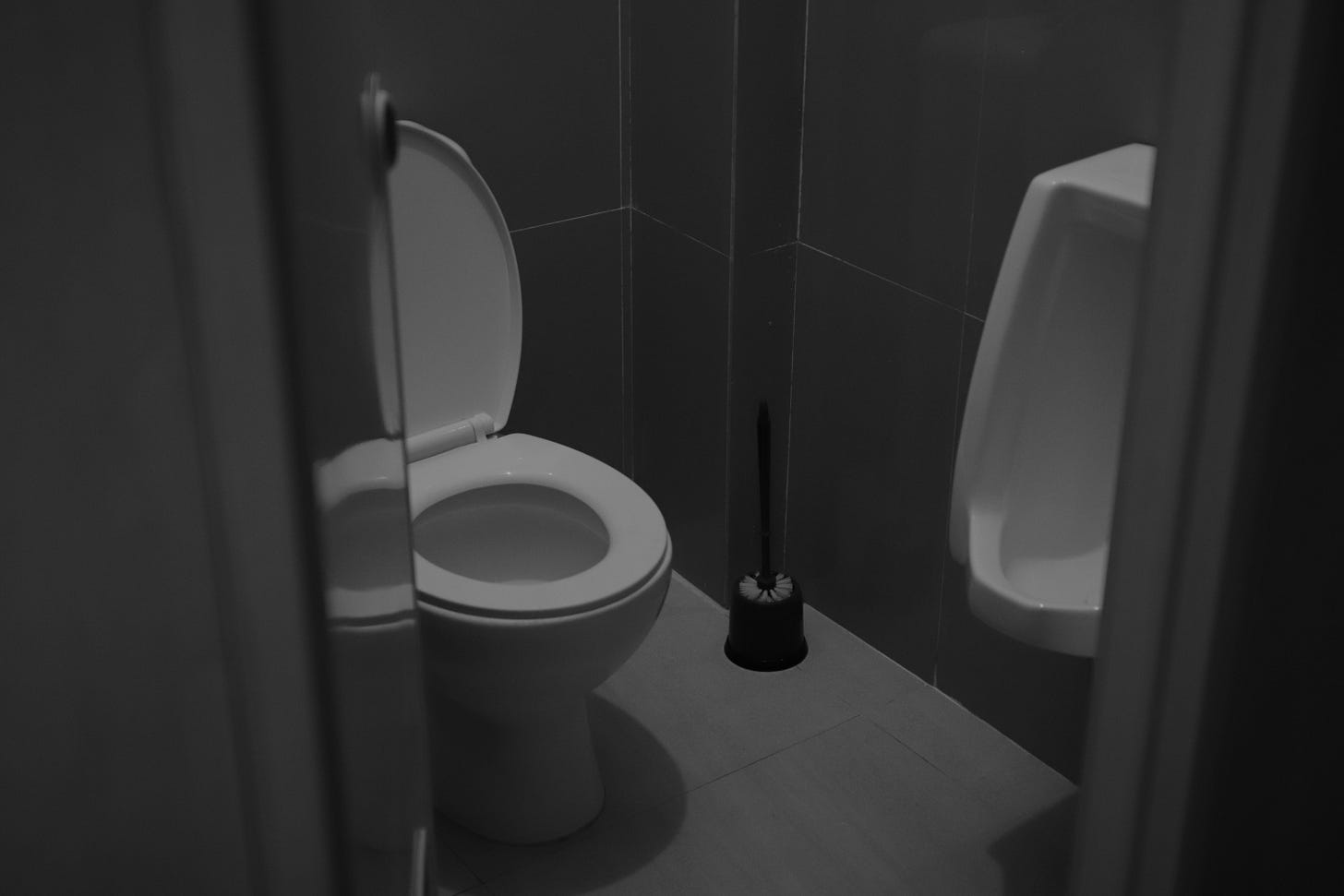I knew I needed a new job when I walked into the bathroom and saw the laminated card over the toilet’s motion sensor.
I’d been living a Groundhog Day existence for a well-known technology company named after a fruit, which I won’t name for respect and fear of retribution. 🍎. Every day seemed the same. While the promise of the job carried dreams, gain, and glory, the role’s reality was repetitive work that my personal CPU could perform while being nearly off. That’s a tech joke for being nearly asleep.
This unnamed company had a love of brushed aluminum, or as their esteemed industrial designer liked to call it, aluminium. He was British, and extremely so – he’s now a knight. So we’ll excuse him. But the thing we shouldn’t excuse is the thousands of litres of wasted water as their staff toilet’s IR beam would bounce off the brushed aluminium door and flush constantly throughout the day. One day I’d had enough and went rogue on the company’s stringent design standards, placing a Post-It note over the flush sensor with a scrawled explanation and apology that people would need to use their hands to flush the toilet.
And with that, this tragic water-waster resumed its role as a normal toilet. It stopped flushing all day long after my Post-It barricaded the infrared emitter, the reflective stall door, and the infrared receiver. An expensive control mechanism designed to optimize human comfort and reduce germ-transmission had gone haywire, and with my simple intervention I defied the company’s authoritarian design standards, and saved enough water to fill a few swimming pools.
Where was the problem? Was the reflective aluminium door the culprit? That’s hating the player, when we need to look at the game. As Demetri Martin puts it, an automatic paper towel dispenser is a solution to something that was never a problem.
I get it – we’re squeamish about using our hands to touch door handles when germs are flying around a bathroom like a squadron of Kamikaze planes. And that paranoia got supercharged during COVID when people would keep 6’ of distance even from their own reflection in a mirror for fear it could get them sick (or the cleverest among us, only 3’ of distance, knowing the reflection has the same distance to travel). Have you ever waded through a pile of paper towels discarded at the base of a public bathroom’s door, a horde of tree pulp used as a rudimentary, disposable glove to create a barrier between bathroom users’ now-clean hands and the filthy door handle?
Leave it to the engineers; a few must have been watching Mission Impossible or Lord of the Rings or working for NASA. How do you solve this problem of filthy faucets?Lasers. Infrared. Magic. The appeal is clear: feel like David Blaine when you walk away from a touchless toilet, wave your hands to dispense a dollop of soap, and in a graceful movement that shouldn’t even interfere with your hand-washing, dispense clean water. Nobody can leave a faucet running and walk away. Like the Segway, the solution seems elegant.
Except that it isn’t. These infrared sensors cost hundreds of dollars (like, many hundreds of dollars) and have loads of ways to malfunction, whether it’s a reflective surface in a bathroom stall or the simple fact that water is splashing around and water wreaks havoc on everything. Funny design for a sink, isn’t it?
Seems like we’re in a real pickle. What are we to do? If only we had extra limbs that we didn’t use to pick up food and touch our faces with, maybe even limbs that are not being used other than for standing on, and are covered up almost all the time that they’re in areas with fearful Kamikaze germs. This one might be unsolvable, but gee whiz. It sure would be great if we had those extra limbs to manipulate things with.
Even though faucets and toilets and doors in public bathrooms are a slightly narrow use case, if someone were to dominate this space they’d probably end up being richer than God. But let’s look elsewhere because this may not be the first time someone has proposed the idea of using limbs other than our hands to control things.
All roads lead back to the Singer treadle sewing machine, don’t they? With a sewer’s hands occupied, clever Isaac Merritt Singer realized the sewer’s feet were doing nothing other than tapping whimsical waltz rhythms and could be put to productive use; their feet could power the machine. Or how about the electric guitarist, with both their hands occupied on their instrument, and wanting to peel the skin off the audience’s face by adding distortion – what does this guitarist do? Wave their head in front of a magical sensor? No! They use their feet on a pedal board, with big switches that even the clumsiest, boot-wearing guitarist can hit with ease.
Electric guitar pedals are a fairly recent innovation when it comes to using the feet to make music – good old Uncle Johann (Bach, that is) would be horrified to discover that his delicate figure-bass-footwork hadn’t been adapted into everyday faucet use when he was fuegin’ in 1720 and using his feet to play bass lines on those massive pipe organs. And while we’re on the topic of old tech, how about potters using their feet to kick a wheel around? They’ve been doing this for thousands of years, and then got a little fancier in during the medieval times by adding in pedals and flywheels, and then a little fancier after Edison electrified everything – but that ornate mug you’re drinking your coffee from? You guessed it. Feet were used in its creation.
Dentist drills, dictation machines, the list goes on. But maybe these are all technical, creative applications and faucets are just too much of an everyday phenomenon. But wait – haven’t you ever opened a trash bin with its foot pedal?
I don’t know why we’ve permitted this insane over-engineering of faucets and under-engineering of public doors, but we can do a whole lot better. To be fair, there are hopeful steps (ha!) happening in the direction of this enlightened way of moving through the world. The StepNpull lets users do… well exactly what the descriptive name suggests. With such a literal name you’d think it was created by Germans, but no, they’ve graced us with the Metiba foot-operated door opener:
Now, I realize this post may seem like a whole lot of ado about nothing. My editor tried to prevent me from posting this but I delivered a swift kick which he didn’t see coming because he’s so hand-centric, and after whimpering off he left me alone long enough to finish and share this diatribe.
But really, what’s the point in all this? Do we really care that much about faucets and soap dispensers? The first point is that we have conspiracy theorists running around calling people sheep for not questioning every message delivered to them by an outside source, and needing to topple the Illuminati or something … and all the while they’re accepting one of the most senseless overuses of technology every time they wave their hands like wizards in a washroom. (And can you imagine how much water you’d save when washing dishes with a foot-controlled kitchen faucet?)
This is the most fundamental aspect of design thinking – know what you aim to accomplish (like, getting your hands wet), and don’t taking anything for granted just because it’s commonly available. Improvements are possible, but the problems are 99% Invisible.
The second point isn’t entirely unrelated to my first point, but it has more to do with the use of our bodies than the manipulation of the world around us. I recognize this entire diatribe assumes the use of working legs, and that’s not the case for every body. However, in bodies with a pair of working legs, we tend to use them for very few things – a bit of walking, sometimes running, delivering swift kicks to your nosy editor, etc. When was the last time you jumped??
Our feet have spent a gazillion years evolving from little fish eggs, have 26 bones in each foot, and we wrap them up in shoes and fold them under our desk chairs. The physical well being that can come from using our feet to do a few extra things shouldn’t be underestimated. I’m not talking about using a spoon or sealing envelopes. Those foot bones are connected to those shin bones which are connected to our brains. And with the high priests of our medical society being neuroscientists, I find it a little strange we don’t advocate for more diverse uses of our bodies, even if that diversity doesn’t extend beyond opening a door or flushing a toilet with those underdog limbs.
We can do better than this, and complexity isn’t always the answer.
And speaking of simplicity, it was on a particularly dull day working for that technology company that I came into the bathroom, saw my infrared sensor Post-It had been upgraded to a laminated card by someone else, and realized this was the only lasting impact I’d achieved in 18 months of work. Much like piles of hardly-used paper towels lying around public bathroom doors, it was a sign that something needed to change.
As Nancy Sinatra says, those boots are made for walking, and that’s just what I did.










Brilliant and hilarious and so true.
Way back when I was in grades 2-7, the school I went to had a foot controlled circular washing basin in the gym change area. Easily 6 kids could fit around and all wash their hands at the same time.
We marvel at modern inventions but oftentimes, they’re recycled old idea.